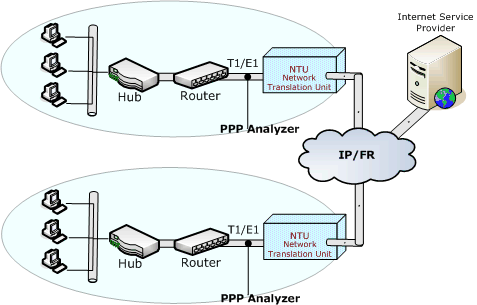Newsletter: GL Communications Releases PPP Protocol Analyzer
Welcome to the second July issue of GL Communications' Newsletter providing information and insight into our latest product, PPP Protocol Analyzer software for Ultra T1 and Ultra E1 hardware cards.
The Point-to-Point protocol (PPP) is a link layer protocol, which is generally used to establish a direct connection between two network nodes over a serial link. PPP encapsulates other network layer protocols like IP, for transmission on synchronous (like T1/E1) and asynchronous communications (like dialup) lines. When transmitted over T1/E1 line, PPP frames are based on HDLC frame structure.
Today, the PPP protocol standard finds wide use in synchronous connections between LANs, bridges, routers, and other intermediate devices. Even DSL service providers use PPP for connecting different nodes in a DSL network. PPP, generally used across a WAN, can also be used in the LAN (known as PPPoE i.e. PPP over Ethernet) for secure communication. Two major features of PPP protocol are:
- Authentication (PAP and CHAP protocols)
- Encapsulation of higher layer protocols (BPDU)

GL's PPP Protocol Analyzer is based on the same feature-rich architecture as other GL's protocol analyzers. It can capture and analyze a suite of PPP protocols such as LCP, NCP, PPP BPDU, PAP, CHAP, HTTP, SNMP, FTP, DNS, and DHCP. The tool allows a test engineer to monitor, capture, and perform numerous measurements across WAN-LAN or LAN-LAN connections. It also includes the ability to test and analyze HDLC-based PPP protocols in a synchronous environment. Some of the main features of the PPP protocol analyzer are listed below:
Supported Protocols
- LCP (Link Control Protocol)- LCP is responsible for establishment, release, and maintenance of a PPP link between two PPP nodes.
- PAP (Password Authentication Protocol)- PAP is used by the peer entity to establish its identity in PPP session.
- CHAP (Challenge Authentication Protocol)- CHAP is used to periodically verify the identity of the peer.
- LQR (Link Quality Report)- Packets are sometimes dropped or corrupted because of noise and equipment problems. LQR helps in monitoring the quality of PPP link.
- BPDU (Bridging PDU)- BPDU encapsulates other higher layer protocol e.g IP based protocols. This protocol enables the interconnection between two remote LANs via PPP link.
- NCP (Network Control Protocol)- NCP enables the selection of specific options and control protocols at connection time across LAN-WAN connection.
Among the IP based application protocols, GL's PPP analyzer currently can decode the following protocols-SNMP, DNS, DHCP, STUN, HTTP, FTP, and ICMP.
Analysis Features
- Compatible with Windows 2000/XP/Vista Operating Systems with user friendly GUIs.
- Works with GL's field proven Ultra E1 or T1 internal cards or Laptop E1 or T1 external units. Other interfaces also available soon.
- Supports analysis in real-time as well as offline.
- Supports both PPP routed and PPP bridged protocols.
- Supports data transmissions on single channel, sub channels or hyper-channels.
- Allows exporting detailed information to an ASCII file: all captured frames or only filtered frames defined by a comprehensive filter criterion and raw frame data as hexadecimal and ASCII octet dump.
- Allows exporting summary information to a comma-delimited file for subsequent import into a database or spreadsheet.
- Supports statistics display based on frame count, byte count, frames/sec, bytes/sec, and more for the entire capture data.
Network Surveillance
Call records and message trace can be monitored remotely and centrally using NetSurveyor™.
Central monitoring features include:
- Ability to view CDR and Message Trace data in real-time from anywhere in the world using the Internet
- Ability to sort and filter protocol data.
An application note has been provided describing NetSurveyor™ and a live demo at the following links: Network Surveillance and Live Demo.
 Back to Latest News Page
Back to Latest News Page